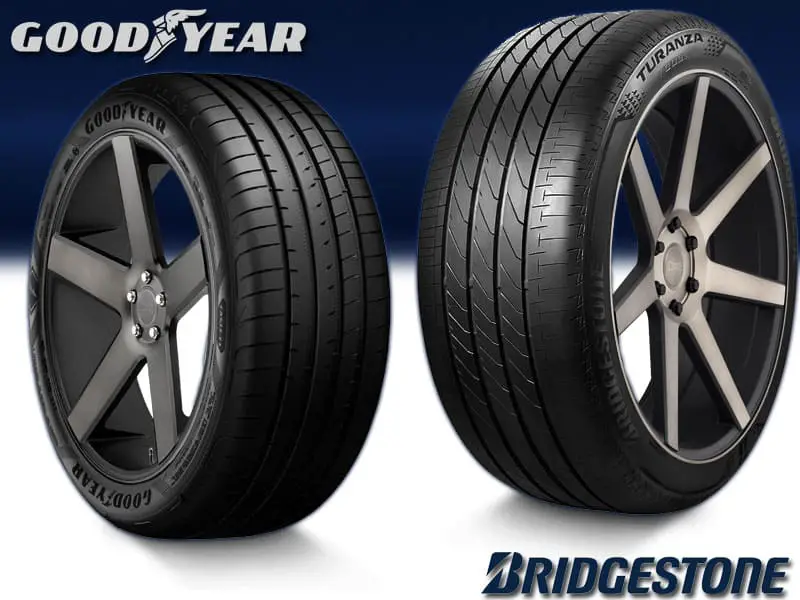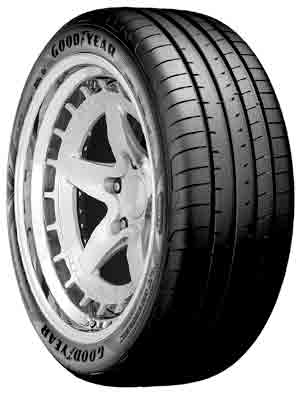Both summer tires (225/55 R17) were compared under similar conditions. Asymmetric 5 has a relatively lower void ratio and broad shoulders, providing superior wet and dry traction along with extreme hydroplaning resistance.
While Turanza T005 with a higher void ratio focuses on providing an average dry and wet traction with a superb hydroplaning resistance. The T005 takes a lead on its counterpart in terms of treadwear resistance due to the stronger built.

Let’s dive in, but before make sure you also check out Bridgestone Turanza vs Goodyear EfficientGrip.
Table of Contents
Comparing Asymmetric 5 with Bridgestone Turanza
Goodyear Eagle F1 Asymmetric 5

Bridgestone Turanza T005



Asymmetric 5 as the name indicates features an asymmetrical five-pitch tread design with two ribs and one tread block column between its shoulders. This tire features a total of four circumferential grooves which are narrow but deep, with one of these slightly narrower and shallower than the rest. This tire has no lateral grooves which is compensated by its wider and deeper sipes engraved around its shoulders. The tread block column is divided into separate elements by the sipes running laterally through them. The sipes also extend inwards a little on each rib from a single direction. The sipes follow an inclined angle of approach on the central rib while penetrating from the direction of the tread block column whereas the other rib has perfectly perpendicular sipes penetrating from the direction of the external shoulder. The shoulder blocks are wider and separated by full-depth sipes.
In the case of T005, it also features an asymmetrical five-pitch tread design but with slightly wide but shallow four circumferential grooves, dividing the tread into three columns and two shoulder rows. There are no ribs present in this tire and only has three tread block columns between its shoulders. Blocks in the column are separated by straight sipes running through them at an inclined angle. Its shoulders are divided into separate blocks by lateral grooves running through them, unlike the sipes dividing the shoulder in the other tire. However, these lateral grooves don’t connect with the circumferential grooves of this tire. Its shoulder blocks are relatively smaller with no sipes present on them.
Grip Comparison
Asymmetric 5 has a higher contact patch because of its two ribs, allowing this tire to effectively grip the road, thus, resulting in a lower dry braking distance of 114.5 inches. On wet roads, this tire is effective due to its deeper sipes, resulting in a lower wet braking distance of 161.7 inches. Both the dry and wet braking distances of this tire are lower than its counterpart, making it superior in terms of on-road grip in all conditions.
T005 lacks a decent contact patch with the road since it has no ribs. Therefore, this tire is unable to maintain effective grip and increase its dry braking distance. It has a dry braking distance of 116.4 inches which is slightly higher than its competitor. This tire has numerous sipes but are not as deep as that of other tire, resulting in a wet braking distance of 168 inches, a little higher than the other tire.
Handling Comparison
A higher shoulder block length is the key to better dry handling, since the Asymmetric 5 has a comparatively higher shoulder block length, therefore, allows a lower dry handling time of 56.2 seconds for completing a certain circular lap. Whereas, in wet conditions, the full depth sipes engraved along its shoulder ensure this tire’s superiority and result in a lower wet handling time of 88.5 seconds.
On the other hand, T005 has a comparatively lower shoulder block length of its shoulders. This increases its dry handling time up to 56.8 seconds. In wet conditions, since this tire has no sipes, therefore, its wet handling time is also higher. This tire completes a lap in 90 seconds around a circular track in wet conditions (higher compared to its counterpart).
Comparison of Hydroplaning Resistance
A combination of longitudinal and lateral grooves is responsible for the efficient passing of the water through the tire’s tread. In the case of Asymmetric 5, it has narrow but deeper grooves present, which allows a higher float of 58.9 mph, even though it has no lateral grooves.
Surprisingly, T005 even with both lateral and longitudinal grooves has the same float speed of 58.9 mph. A similar speed is simply because it has wider but shallower grooves which are balanced by the narrow but deeper grooves of Asymmetric 5. Hence, they both perform equally well on a flooded road.
Comparison of Rolling Resistance
Due to the higher contact patch, the Asymmetric 5 faces more rolling resistance since greater friction is needed to be overcome for this tire to move. It has a rolling resistance of 8.85 kg t; hence a large amount of fuel is utilized to overcome this resistance, resulting in lower fuel efficiency of this tire.
T005 has a lower contact patch, therefore, it faces lower frictional generated resistance to roll. Therefore, it has a rolling resistance of 7.12 kg t, much lower than its counterpart, which increases the tire’s fuel efficiency since a lesser amount of fuel is wasted in countering hysteresis.
Comfort and Noise Comparison
The Asymmetric 5 has narrow grooves which provide a lesser space for air particles to get trapped. Therefore, a lower amount of air particles striking against the walls of the grooves produces lesser noise of 71.3 dB. Whereas the subjective comfort of the tire is also higher since it performs better in both dry and wet conditions.
The wider grooves of T005 result in a noisier tire since its wider grooves allow many air particles to get stuck within them, which striking against its walls, produces a louder noise of 72 dB. This tire has comparatively a lower subjective comfort score due to its lower performance in all conditions.
Durability and Treadwear Differences
The softer rubber compound used inside the tread of Asymmetric 5 allows it to outperform its competitor in all fields but at a cost of lower treadwear resistance. It has a higher rolling resistance which increases its treadwear. Since the tire is not durable enough to sustain such wear, therefore, its mileage is much lower.
On the side T005, excels in treadwear resistance due to the harder rubber compound used in its tread, increasing its treadwear resistance. This makes the tire durable and provides better mileage due to the combined effect of higher durability and lower rolling resistance, causing lesser treadwear.
Price Differences
Asymmetric 5 is a higher-priced tire, providing better traction in all conditions along with improved hydroplaning resistance as well. Whereas the T005 focuses on providing a balanced performance for many miles. Asymmetric 5 is for the drivers not willing to compromise on performance while T005 targets consumers who are looking for a budget-friendly medium performance tire.
Quick Summary
- Both the tires are summer tires.
- Asymmetric 5 has better dry and wet traction
- Both provide equal hydroplaning resistance.
- T005 has lower rolling resistance and better fuel efficiency.
- Asymmetric 5 is more comfortable in terms of both noise and performance.
- T005 is more durable and provides higher mileage.
- Asymmetric 5 is a highly-priced tire compared to T005.


